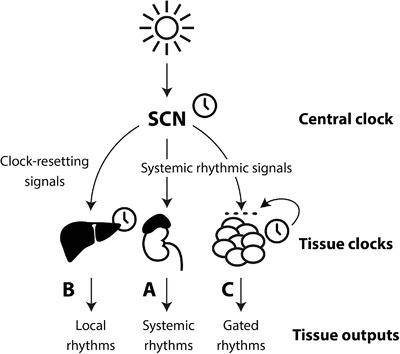Our official English website, www.x-mol.net, welcomes your
feedback! (Note: you will need to create a separate account there.)
The Tissue Clock Network: Driver and Gatekeeper of Circadian Physiology: Circadian rhythms are integrated outputs of central and peripheral tissue clocks interacting in a complex manner - from drivers to gatekeepers.
BioEssays ( IF 3.2 ) Pub Date : 2020-03-01 , DOI: 10.1002/bies.201900158 Lisbeth Harder 1 , Henrik Oster 1
BioEssays ( IF 3.2 ) Pub Date : 2020-03-01 , DOI: 10.1002/bies.201900158 Lisbeth Harder 1 , Henrik Oster 1
Affiliation

|
In mammals, a network of cellular circadian clocks organizes physiology and behavior along the 24-h day cycle. The traditional hierarchical model of circadian clock organization with a central pacemaker and peripheral slave oscillators has recently been challenged by studies combining tissue-specific mouse mutants with transcriptome analyses. First, a surprisingly small number of tissue rhythms are lost when only local clocks are ablated and, second, transcriptional circadian rhythms appear to be regulated by a complex mix of local and systemic factors. As reviewed here, these findings suggest a more integrated model of clock network interaction with the central pacemaker as the main source of behavioral and systemic-physiological rhythms and peripheral clocks controlling some local rhythms while at the same time acting as gatekeepers that temporally adjust cellular responses to external stimuli.
中文翻译:

组织时钟网络:昼夜生理学的驱动器和看门人:昼夜节律是中枢和外周组织时钟以复杂方式相互作用的综合输出——从驱动器到看门人。
在哺乳动物中,细胞生物钟网络沿着 24 小时的一天周期组织生理和行为。具有中央起搏器和外围从属振荡器的生物钟组织的传统分层模型最近受到将组织特异性小鼠突变体与转录组分析相结合的研究的挑战。首先,当仅消融局部时钟时,会丢失数量惊人的组织节律,其次,转录性昼夜节律似乎受局部和全身因素的复杂组合调节。正如这里所评论的,
更新日期:2020-03-01
中文翻译:

组织时钟网络:昼夜生理学的驱动器和看门人:昼夜节律是中枢和外周组织时钟以复杂方式相互作用的综合输出——从驱动器到看门人。
在哺乳动物中,细胞生物钟网络沿着 24 小时的一天周期组织生理和行为。具有中央起搏器和外围从属振荡器的生物钟组织的传统分层模型最近受到将组织特异性小鼠突变体与转录组分析相结合的研究的挑战。首先,当仅消融局部时钟时,会丢失数量惊人的组织节律,其次,转录性昼夜节律似乎受局部和全身因素的复杂组合调节。正如这里所评论的,











































 京公网安备 11010802027423号
京公网安备 11010802027423号